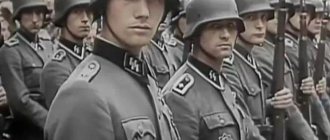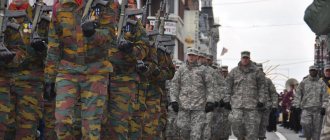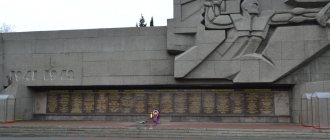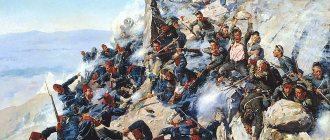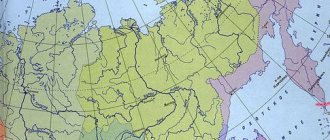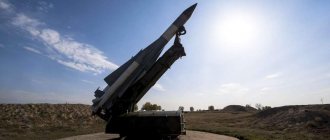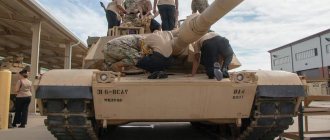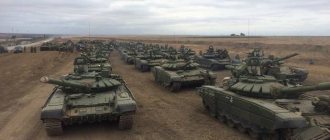8th Panzer Division
Place of permanent deployment: Cottbus (III Military District).The 8th Panzer Division was formed in 1938 as the 3rd Light Division. At that time, it included the 67th tank battalion, the 8th and 9th mechanized cavalry regiments and the 8th reconnaissance regiment. In 1939, the division took part in battles in Poland and in the winter of 1939/40 returned to Cottbus, where it was reorganized into a tank division. On October 16, 1939, the division was renamed the 8th Panzer and received the 10th Tank Regiment (East Prussian), as well as the newly formed headquarters of the 8th Motorized Brigade, which included the 8th Motorized Regiment and the 8th Motorcycle Battalion. Also, the 8th Panzer Division lost one of its two reconnaissance battalions, transferred to the 10th Panzer Division. Later, on January 1, 1941, the 67th Tank Battalion joined the 10th Tank Regiment, becoming the III Battalion of the regiment. Meanwhile, the division, equipped mainly with weak Czech tanks, as part of Reinhardt's XXXXI Motorized Corps, took part in battles in Belgium and France and suffered heavy losses while crossing the Meuse River. She later took part in the defeat of the 1st and 7th French armies and the final stage of the 1940 campaign in France. The division remained in France until March 1941, and then was transferred to the east, where in April it fought in Yugoslavia as part of the 1st Panzer Group. By April 7, it concentrated north of Lake Balaton in Hungary, crossed the Danube on April 10, reached the outskirts of Belgrade on April 12, and entered Sarajevo almost without resistance on April 15. Here the division accepted the surrender of the Yugoslav 3rd Army. Yugoslavia itself capitulated two days later.
After a quick transfer to East Prussia, the 8th Panzer Division entered the Soviet Union as part of Manstein's LVI Panzer Corps, moving at the forefront of the German attack in the Baltic states. Within a few days, she captured the bridges on the Western Dvina and got involved in stubborn battles to retain and expand the bridgehead. By order of the indecisive Supreme High Command, the 8th Panzer Division was to advance along the marshy banks of the Mshaga River through terrain completely unsuitable for tank operations. By mid-July, combat losses and malfunctions had reduced the number of tanks in the division from 175 vehicles to 80. On August 5, at the very beginning of the battle on the Luga line, the division was withdrawn to the reserve of Army Group North and, despite the objections of its commander, was ordered to clear communications from the partisans. This use of a tank division was extremely ineffective.
At the beginning of October 1941, the 8th Panzer Division returned to the front to carry out its inherent tasks, taking part in the battles for the bridgeheads on Volkhov and in the attack on Tikhvin. As part of Army Group North, the division helped contain the winter offensive of Soviet troops in 1941/42 in the Volkhov direction. The following year, the division fought defensive battles as part of Army Groups “North” and “Center” (including near Kholm, Orel and Smolensk), and then, after the failure of the offensive near Kursk, it was transferred to the southern sector of the Eastern Front. In October 1943, she suffered losses during the retreat from Kyiv. In 1944, the division fought almost continuously, first near Zhitomir in northern Ukraine, then near Tarnopol (Ternopol), Brody, in southern Poland, near Lemberg (Lvov), during the retreat to the Carpathians and in Slovakia. In December, the 8th Panzer Division was transferred to Hungary, from where it retreated to Austria in 1945. The end of the war found the division in Moravia, in the central sector of the Eastern Front, where the division surrendered to Soviet troops in the Brunn (Brno) area on May 10, 1945.
The division was part of the following formations:
Date
| Corps (Armeekorps) | Army | Army Group (Heeresgruppe) | Location | |
| 00.10.1939 | in Aufstellung | BdE | Heimat | |
| 00.12.1939 | reserve | — | B | Niederrhein |
| 00.01.1940 | reserve | — | B | Niederrhein |
| 00.05.1940 | reserve | 12th A | A | Eifel, Belgium |
| 00.06.1940 | XXXXI | Guderian (12.) | A | France |
| 00.07.1940 | XV | 2nd A | C | France |
| 00.11.1940 | XXXXI | 6th A | A | France |
| 00.01.1941 | reserve | 1st A | C | Heimat |
| 00.03.1941 | XXXXI | 2nd A | D | France |
| 05.04.1941 | XXXXVI | 2nd A | OKH | Austria |
| 00.04.1941 | LIX | 4th TGr | Yugoslavia | |
| 00.05.1941 | BdE | Protectorat | ||
| 00.07.1941 | LVI | 4th TGr | North | Pleskau, Lugau |
| 00.08.1941 | reserve | 4th TGr | North | Narwa, Leningrad |
| 00.09.1941 | XXXXI | 16th A | North | Valdai |
| 00.10.1941 | XXXIX | 18th A | North | Valdai |
| 00.01.1942 | reserve | — | North | Leningrad |
| 00.02.1942 | reserve | 16th A | North | Leningrad |
| 00.03.1942 | XXXIX | 16th A | North | Hill |
| 00.08.1942 | Brandenberger | — | North | Hill |
| 00.12.1942 | LIX | — | Center | Smolensk, Bryansk |
| 00.01.1943 | LIX | — | Center | Smolensk, Bryansk |
| 00.02.1943 | XXXXIII | 3rd TA | Center | Velizh |
| 00.04.1942 | reserve | — | Center | Eagle |
| 00.08.1942 | XXIII | 2nd TA | Center | Eagle |
| 00.09.1942 | LVI | 2nd A | Center | Gum |
| 00.10.1942 | LIX | 4th TA | South | Kyiv |
| 03.11.1942 | XIII | 4th TA | South | Zhytomyr |
| 02.12.1943 | XXXXII | 4th TA | South | Zhytomyr |
| 24.12.1943 | XXXXVIII | 4th TA | South | Zhytomyr |
| 01.01.1944 | XXXXVIII | 4th TA | South | Vinnitsa |
| 00.02.1944 | XXIV | 4th TA | South | Tarnopol |
| 00.04.1944 | XXXIX | 4th TA | Northern Ukraine | Tarnopol |
| 00.05.1944 | reserve | 4th TA | Northern Ukraine | Tarnopol |
| 00.06.1944 | reserve | 1st TA | Northern Ukraine | Brody, Lviv |
| 00.07.1944 | III | 1st TA | Northern Ukraine | Brody, Lviv |
| 00.08.1944 | LIX | 17th A | Northern Ukraine | Brody, Lviv |
| 00.09.1944 | XXIV | 1st TA | Northern Ukraine | Karpaten |
| 00.10.1944 | XXIV | 1st TA | A | Slowakei |
| 00.11.1944 | reserve | 6th A | A | Slowakei |
| 00.12.1944 | XXIX | 6th A | South | Budapest |
| 01.01.1945 | LVII | 6th A | South | Budapest |
| 00.02.1945 | 17th A | Center | Mährisch Ostrau | |
| 00.04.1945 | reserve | 1st TA | Center | Mahren |
The end of the “bad karma division”
In descriptions of the battles on the Kursk Bulge, authors usually focus on the events that took place on the southern front. The “registered” divisions of the Wehrmacht and SS were assembled there, and the famous battle near Prokhorovka station took place there. When talking about battles on the northern front, the main attention is often paid to the actions of the Ferdinands. Of course, these self-propelled guns were a dangerous enemy, but due to their small numbers they simply could not play a decisive role in an operation of this scale. The main “workhorses” of Colonel General Walter Model were to be ordinary “numbered” tank divisions, which did not receive either the latest tanks or big names. But the course of the battles on the northern front largely depended on their actions. It was their failure that predetermined the failure of the offensive of Army Group Center and, subsequently, the entire Operation Citadel - the Reich’s last attempt to maintain the strategic initiative on the Eastern Front. One of these divisions was the 18th Panzer Division.
Path to the Citadel
For the 18th Panzer Division (TD), formed in October 1940, Operation Barbarossa was a baptism of fire. She acted as part of the 2nd Panzer Group of Colonel General Heinz Guderian, and the campaign to the East was not an easy walk for her from the first days. Having begun the invasion fully equipped with 17,174 men and 212 tanks, the division suffered nearly 6,000 casualties over the course of 60 days of fighting. Already by July 9, the 18th TD could throw only 83 serviceable tanks into battle, but the Russians stubbornly refused to give up, and by the end of the month there were only 12 combat-ready tanks left. Moreover, the losses could not be attributed to unsuccessful command, since he “ruled” the division former chief of staff of Guderian's group, experienced tank general Walter Nehring. When he was promoted on January 26, 1942, there were still 10,459 people in the division, but only 5,443 of them were combat-ready.
"Ferdinands" knocked out on the northern face of the Kursk Bulge
In the summer of 1942, the 18th TD found itself aloof from the major events planned by Hitler on the southern sector of the front, but found itself at the epicenter of the plans of the Soviet command in the central direction. However, indirectly, it still took part in the offensive in the south: two tank battalions were withdrawn from the 18th TD, which were included in the 3rd and 60th motorized divisions (MD), which later died at Stalingrad. In addition, the division fell into the August offensive of the 3rd Tank Army in the Sukhinichi - Kozelsk zone, which did not add joy to its personnel.
From April 1, 1943, the division was headed by an experienced colonel (from May 1 - Major General) Karl-Wilhelm von Schlieben, who had received the Knight's Cross a couple of weeks before. We can say that he was a “motorized” general, since at the beginning of his military career he led the 108th Motorized Regiment from the 14th Tank Division, which perished in the Stalingrad pocket, into an attack, and then commanded the 4th Infantry Brigade as part of the 4th etc. Considering that by the summer of 1943 the 18th Tank Division had in its composition just one 18th Tank Battalion (TB), then, in fact, the tank division was very similar to the Wehrmacht motorized division during Operation Blau. Therefore, the appearance of von Schlieben in a leadership position was quite justified.
As you know, the commander of the 9th Army, Colonel General Walter Model, built his strike force as follows: on the very left flank, the XXIII Army Corps (AC) of Infantry General Johannes Friesner was advancing, consisting of three infantry divisions, reinforced by the 185th and 189th divisions of assault guns, then closer to the center was the XLI Panzer Corps (tk) of General of the Tank Forces Joseph Harpe, consisting of the 86th and 292nd infantry divisions (inf), where the 18th td stood in the second echelon. In addition to the 177th and 244th assault gun divisions (each with 22 Stukas and nine Stukas), the corps was reinforced by an “exotic beast” in the form of the 656th tank destroyer regiment on Ferdinands and Brummbars, and also the 313th and 314th companies of “disruptive” teletankettes “Borgvard” B IV. In total, XLI Tank had 304 tanks and self-propelled guns. Firepower was provided by 182 artillery barrels, 36 Nebelwerfers of 150 mm caliber and 18 Nebelwerfers of 210 mm caliber.
In this motley company, the 18th TD went to the Citadel. If you look at the map of the offensive, you can see that Model’s plan was dictated by the realities of logistics: XXIII AK captured the Maloarkhangelsk railway station and moved as far as possible to ensure the safety of supplies and railway transportation of the strike group. Similarly, the XLI Tank captured the Ponyri station (in fact, this toponym hides the Ponyri station, as well as two villages - the 1st Ponyri and the 2nd Ponyri), securing the left flank of the 9th Army, where its striking force operated - the XLVII Tank General tank troops of Joachim Lemelsen as part of the 6th Infantry Division, as well as the 2nd, 9th and 20th Panzer Divisions. The corps was reinforced by the 505th battalion of Tiger tanks and the 312th company of Borgward B IV "disruptive" teletankettes. Assault guns were represented by the 904th (31 pieces) and 245th (22 pieces and nine pieces) divisions. In total, the corps had 331 tanks and self-propelled guns. Firepower was provided by 184 artillery barrels, 18 Nebelwerfers of 150 mm caliber and 36 Nebelwerfers of 320 mm caliber.
Defense diagram of the Soviet 29th Rifle Corps in the Ponyri area
In principle, the striking power of the Model ended with these two hulls. Next was the XLVI tank of Infantry General Hans Zorn. The corps was tank only on paper, since it consisted of only four infantry divisions, reinforced by the 909th assault gun division (27 “stukas” and four “stukas”). In order to at least slightly justify its name, on the eve of the offensive, on Model’s personal initiative, the corps received one tank company from the 12th TD. At that moment, it had eight “long” PzKpfw IVs and one “short” PzKpfw III. Located on the very right flank of the 9th Army, the XX Army of Artillery General Rudolf von Roman also consisted of four infantry divisions, but had no active tasks in the upcoming offensive.
Model's reserve included the 4th and 12th TDs, which had 168 tanks, as well as the 10th Panzergrenadier Division (PGD). If necessary, Model could use the 25th PGD, as well as the 5th and 8th TDs from the 2nd Tank Army.
Despite the axiom established in historiography that Model’s divisions went into battle rather weak, the numbers indicate the opposite. The 18th TB had 31 PzKpfw III (“long” and 75 mm “short”) and 38 PzKpfw IV (mostly 75 mm “long”), which, of course, did not reach the regular strength of the battalion in 1943, but and did not make the division an outsider. Also in the 18th TD there were eight Marder anti-tank self-propelled guns and 20 Pak 40 towed anti-tank guns. In terms of personnel, the division did not reach the “fattened” SS units or Manstein’s replenished tank divisions, but it did not look completely weak either. As of July 1, its combat strength included 202 officers, 962 non-commissioned officers and 5,414 soldiers, and a total of 270 officers, 1,674 non-commissioned officers and 8,171 soldiers were on payroll, of which 560 people were from units assigned for reinforcement. There are other data according to which on July 4 the 18th TD numbered 12,028 people.
Red Army soldiers examine a German plane shot down in the Ponyri area
The 18th TD did not have an independent offensive line, but its 101st Panzergrenadier Regiment (PGR) under the command of Lieutenant Colonel Paul Fleischauer was allocated to strengthen the offensive impulse and onslaught of the 292nd Infantry Division of Lieutenant General Wolfgang von Kluge, the younger brother of Field Marshal Hans -Gunther von Kluge. Since the winter of 1941, the division fought in two regiments: the 507th Infantry Regiment (Infantry Regiment) of Colonel Hans Hane and the 508th Infantry Regiment of Colonel Georg Zierhold. Deprived of reserves and reinforcements compared to the “Fuhrer’s favorite” Manstein, the commander of the 9th Army tried to make the most efficient use of the resources available to him.
Also, the 88th tank artillery regiment of the 18th TD participated in artillery preparation from the first day of the offensive. In the first three decisive days, it with the headquarters, 1st and 2nd divisions, as well as a battery of anti-aircraft guns was transferred to the subordination of the 292nd Infantry Division. The 3rd Division of the 88th Tank Artillery Regiment and the 88th Observation Battery reinforced the 86th Infantry Division. They returned to the 18th TD only on July 7th.
By the beginning of the offensive, the division was fully concentrated and ready to carry out the order. In accordance with it, the 18th TB was supposed to support the attack of the 292nd Infantry Division along the western road and punch a hole for this division to break through. If the breakthrough is successful, then, without waiting for the approach of other forces of the 18th TD, it is necessary to break through further to height 260.5 and there await the approach of the reinforced 18th reconnaissance battalion. Together with them it is necessary to strike further to a height of 258.5. Fleischauer's reinforced panzergrenadier regiment, after a successful breakthrough in the 292nd Infantry Division, was to go into the corps reserve, and the division headquarters was to move to the 1st Ponyri.
A clutch of Soviet 45mm cannons is towed to the front
On the afternoon of July 4, preparations for the offensive were completed. Division headquarters believed that Fleischauer's 101st Regiment would be so well supported by the artillery of the 292nd Infantry Division that his breakthrough would be successful. Colonel General Model visited the division command post in the forest near the village of Staroye Gorokhovo after lunch, and Major General von Schlieben acquainted him with the deployment of troops before the offensive and with further control of the battle.
On the other side of the front
The Soviet units had long been prepared for the meeting. The task of the Central Front of Colonel General K.K. Rokossovsky’s strategy was in some ways simpler than that of his southern neighbor: there were fewer tank-dangerous areas in the front zone. However, they prepared for defense here no less carefully; since spring, they have been burrowing into the ground themselves and burying a huge number of “gifts” - ordinary mines and powerful landmines from captured shells. The Germans were expected, but no one could say the exact date until the dawn of July 4th.
Around 07:00 to the trenches of the 15th Infantry Division (SD) Colonel V.N. Two defectors left Djandzhgava, Edwin Meking and Stanko Miksic - as recorded in the division report, “Yugoslavs by nationality”; at front headquarters they were transferred to the Slovenians. According to the testimony of Mecking and Miksic, the German offensive was supposed to begin in the coming days.
The reconnaissance company of the 15th Infantry Division put an end to this issue. Having advanced on the night of July 5 to capture the target prisoner, the scouts of Lieutenant I.S. Meleshnikov discovered a group of German sappers clearing passages in the minefields. After a short battle, the reconnaissance group returned to their trenches with the trophy at 24:00. The captured corporal from the 6th Infantry Division, Bruno Fremel, reported that the German offensive should begin at 03:00. It took less than two hours for the necessary information to reach Rokossovsky’s headquarters and return in the form of an order for counter-preparation, and at 02:10 the Soviet artillery opened fire. A few hours later the German guns started talking.
A German PzKpfw III tank burned by soldiers of the 15th Infantry Division
Colonel Dzhandzhgava's division came under attack from several German formations at once. Its positions were attacked by the 292nd Infantry Division with the 101st Regiment Regiment attached to it. A quick breach of the Soviet defense was supposed to be provided by the 244th assault gun division, but it ended up in a minefield reinforced with buried landmines. Immediately after the start of the attack, the self-propelled gun of the commander of the 2nd battery, Lieutenant Hans-Dietrich Rade, was blown to pieces by a powerful explosion - the lieutenant miraculously survived, although he was seriously shell-shocked and lost an eye. The division suffered losses and slowed down the pace of the offensive.
The 101st Rifle Regiment near the village of Ozerki clashed with the 676th Infantry Regiment (JV) of Lieutenant Colonel N.N. Onoprienko was from the 15th Infantry Division and suffered heavy losses. At the same time, Fleischauer showed sluggishness, and the grenadiers lay under fire, without even trying to scout out workarounds. To save the 101st Regiment, units of the 292nd Infantry were forced to stop the attack to the southeast and turn to the rear of the 676th Regiment. However, here the grenadiers also didn’t really want to storm the Soviet defenses without armor and decided to wait for the 244th division of Stugs, which either put their nerves in order, or actually replenished the ammunition for the entire division at once, but in the end the attack to the Russian rear was delayed.
As a result, the 676th Rifle Division, practically surrounded, slipped out of the emerging pocket and retreated to the battle formations of its 15th Infantry Division. According to the report of the regiment headquarters, up to 70 German tanks were knocked out, but in the further report of the division, the sturgeon was noticeably reduced. However, by evening the defense of the 15th Infantry was broken through and was of a focal nature.
To neighbors from the 81st Infantry Division, Major General A.B. Barinova also had difficulty holding back the enemy for some time. Numerous minefields forced German equipment to either greatly slow down the offensive or break away from the infantry, remaining alone with anti-tank artillery. However, by mid-day the superiority of the Germans advancing on a narrow front had an effect. Soviet documents noted that the enemy managed to break through the defense line and reach the positions of artillery and regimental reserves.
The commander of the fire platoon of 45-mm guns of the battery of the 676th joint venture of the 15th infantry division, junior lieutenant I.I. During the battle on July 6, Borisyuk knocked out six German tanks, and his platoon claimed 11 tanks in total. On August 7, Ivan Borisyuk was awarded the title of Hero of the Soviet Union, and a year later, on July 28, 1944, he died in battle. At that time, he was already in command of a battery with the rank of captain.
By 14:00, the battalions of the 467th and 410th rifle regiments were fighting surrounded. It was possible to try to correct the situation with a counterattack of reserves with the support of tanks, but the 27th Guards Heavy Tank Regiment (gttp) transferred to the division on the KV-1S was late: by 15:00 only two tanks arrived. By the time the others arrived, it was no longer necessary to restore the line of defense, but to remove the remnants of the units from the encirclement. The exit of the 467th rifle regiment was covered by fire from the 9th Guards Artillery Brigade. As for the tankers, the infantry spoke disapprovingly of their actions:
“The attack of the 27th gttp, which was intended to facilitate the exit of the encirclement of the 467th regiment, in fact, did not produce real results, since the regiment commander acted extremely sluggishly and uncertainly. The tanks were more marking time, every now and then trying to go back.”
Subordinate at 18:00 to the commander of the 81st Rifle Division, the 129th Tank Brigade (tbr) Colonel N.V. Petrushina acted noticeably more actively: already at 19:00 her tanks entered the battle, breaking through the encirclement for the 519th Regiment. As of July 5, the brigade had 10 KVs, 21 T-34s, 10 T-60s and eight T-70s.
Before lunch on July 6, Colonel General Model arrived at the command post of the 18th TD and ordered the creation of a mobile combat group. It was supposed to move forward to the eastern part of Aleksandrovka at the disposal of the corps. The rest of the division moved to the concentration area between Aleksandrovka and the old front edge of the Soviet defense line.
Soviet T-34 tanks with troops on armor are moving towards the front
All maneuvers and movements were greatly delayed because crossing the Ochka River was very difficult. At first, an auxiliary temporary bridge of the 292nd Infantry Division was used, which failed. Construction of the 24-ton bridge was supposed to be completed in the afternoon, but in fact it was completed only by 02:00 on July 7. However, the division was able to concentrate forces in the specified area. On July 6 at 21:10, the corps transmitted the order via communications:
“The 18th Panzer Division is preparing during the first half of the day on July 7 to attack with tanks through the right wing of the 292nd Infantry Division along the highway and capture the Polevoe-Safonovo section. To do this, the division (without the 101st regiment) with the 52nd regiment must be ready by 11:00.”
By this time, the divisions advancing in front had pushed the snarling 81st Infantry Division towards the positions of the 307th Infantry Division, located in the second echelon of Major General M.A. Enshina. This division was full of automatic weapons and artillery: 2029 submachine guns, 172 light and 70 heavy machine guns, 210 anti-tank rifles, as well as 20 120 mm, 75 82 mm and 33 50 mm mortars, eight 122 mm howitzers , 20 76-mm “divisions”, 12 76-mm “regiments” and 29 “forty-fives”. The next day, the 15th and 81st Infantry Divisions were withdrawn from the battle: the brunt of the battle for Ponyri was to be borne by the 307th Infantry Division.
18th Panzer enters the battle
On July 7, on the third day of the Battle of Kursk, the 18th Tank Division was brought into battle, which deserves a separate discussion. According to the division's war log, there was great Soviet air activity between 04:00 and 06:00. The division commander and the head of the operations department visited the reconnaissance battalion, ordering reconnaissance to be conducted again in the south-eastern and southern directions. It was necessary to reconnoiter the road to 1st Ponyri. Captain Walter Kowitz's engineer battalion was ordered to build a 20-ton bridge. At 10:00 an order came from the corps: the 52nd airborne regiment should take a bridgehead at the 9th TD east of the village of 1st Ponyri as quickly as possible and then strike in a southerly direction to capture height 240.5.
But orders were orders, and the regiment’s progress was very slow, including preparations for the attack on height 240.5. The regiment commander did not want to advance without artillery support, but until lunch it was not clear whether the division had its own artillery regiment at its disposal to support the offensive, or whether it should not be counted on. The regrouping of the divisional artillery (the 88th Tank Artillery Regiment was returned to the division by order on July 7) continued until 21:00, and until the beginning of darkness due to enemy fire it was not possible to move forward observation batteries; there was also no connection to the batteries.
The construction of the bridge in the occupied part of Ponyri was delayed. Heavy artillery fire and fire from guards mortars were fired at this place, and therefore the work was interrupted. New difficulties immediately arose for the 52nd Civil Aviation Regiment, which did not have the opportunity to carry heavy weapons across the bridge. For the whole day, the division command could not organize the attack of one regiment.
Soviet anti-tank crews of the 15th Infantry Division are preparing to repel a tank attack
«One of the most brutal battles during the eastern campaign broke out here.
“,” wrote an officer of the 292nd Infantry Division named Nits. The battle lasted more than five hours and sometimes reached hand-to-hand combat. The northern outskirts of Ponyri changed hands several times. Two battalions of the 1023rd rifle regiment and the 129th brigade took part in the counterattacks from the Soviet side.
As darkness fell, the 52nd Airborne Regiment was ready to attack. Major General von Schlieben demanded that Hill 240.5 be taken, and shortly before midnight a message arrived at the division command post that the Panzergrenadiers had taken the height. Exhausted by continuous 14-hour battles, units of the 307th Infantry Division retreated to a line south of Ponyri. Here the 52nd airborne regiment was stopped and went on the defensive; it managed to advance only 2–3 km. The famous German author Werner Haupt gives the following assessment of the actions of the soldiers of the 307th Infantry Division on July 7:
“The left flank
of the XLVII Panzer Corps, operating in the direction of the main attack, failed to advance further, although by this time the 18th TD of Major General von Schlieben had arrived and moved to the area west of Ponyri to the right of the 292nd Infantry Division to launch an attack along the river Heading south again. But it was here that the brave Soviet 307th Rifle Division stood.”
The clear actions of the 307th Infantry Division and the attached units are entirely the merit of the division commander, General Enshin. Discipline was enforced by draconian measures - for example, when one of the companies of the 27th gttp withdrew from positions in the area of height 248.9 without orders, the division commander returned the company and ordered the company commander to be shot.
Battle for Ponyri
On July 8 at 06:50 in the 18th TD, an order was issued for division No. 27:
“In front of the division’s front, the enemy was thrown back at night from a height of 240.5 to Berezovy Log.
On the right, the 9th Panzer Division reached the Olkhovatka - 2nd Ponyri road with its advanced units. On the left, the 292nd Infantry Division repels numerous counterattacks by the Russian 3rd Tank Corps, focusing on the southern part of Ponyri. On July 8, strong tank attacks should be expected here. The 18th Panzer Division, part of the XLI Panzer Corps, goes over to temporary defense on July 8 to allow the Russian 3rd Panzer Corps to withdraw and destroy its tank units."
According to the combat log, the day went like this:
On the morning of July 8, the division was temporarily subordinated to the 292nd Infantry Division in order to create a unified defense control west of the railway and consolidate the achieved line. Since the 307th Infantry Division with the forces of the 1023rd and 1019th Regiment already from 07:30 was “enveloping” the battle formations of the 292nd Infantry Division, the decision was made to the 18th TB, reinforced by a company of self-propelled anti-tank guns and the 1st company of the 18th reconnaissance battalion, move the 292nd Infantry Division behind the left wing to eliminate the possibility of an enemy breakthrough through the railway line to the north. As a result, the tank battalion, while waiting to complete the mission, suffered heavy losses from mortar and artillery shelling.
At about 11:00, Colonel General Model arrived at the division command post and ordered the right wing of the division to move forward, relieving the left flank of the 9th Panzer Division.
After lunch, the attack began on the 52nd infantry regiment, which remained on the right flank of the 292nd infantry regiment. Its commander, Colonel Friedrich von Seydlitz, was forced to advance without tanks, which suffered losses on the left flank of the 292nd Infantry Division. Little consolation for von Seydlitz was the support of the reconnaissance battalion units. The panzergrenadiers managed to break into the Soviet positions. But “the music didn’t play for long” - the Soviet units carried out an artillery attack and launched a counterattack themselves. What happened next was described in the combat log of the 18th TD:
“At about 18:00, panic began, because one company of the reconnaissance battalion, instead of seeking cover from artillery fire in the reached defense system, ran back. At the same time, units of the Schönbeck battalion (2nd battalion of the 52nd regiment) were also attacked, so much so that all the territories conquered with such difficulty had to be surrendered. Here a large amount of equipment failed, and heavy losses were suffered, as the enemy concentrated artillery and small arms fire on the retreating units. Without proper information to the division, the 52nd attempted to recapture the lost positions. Due to this, losses were suffered again.”
On the evening of July 8, the corps ordered the next day, together with the 292nd Infantry Division, to take Ponyri. Divisional order No. 28 dated 23:50 on July 8 read:
"1. Enemy attacks on Ponyri were repulsed in heavy battles. In front of our front, holding the left wing, it was possible to improve the front line as a starting position for the attack on July 9, the right neighbor reached the Olkhovatka - 2nd Ponyri road.
2. The 18th TD captures the Derlovka line on July 9 – height 256.9.”
According to German data, on July 8, in the area of the Ponyri railway station, five PzKpfw III and one PzKpfw IV were destroyed by Soviet fire, two more damaged PzKpfw III remained on Soviet territory, and one PzKpfw IV and one command PzKpfw III went to the rear for repairs. The number of damaged vehicles and those repaired by the division's repair fund is unknown.
The losses of the 307th Infantry Division for July 7–8 amounted to 1,306 people killed and wounded. Equipment losses: three 45-mm guns, three 76-mm guns, one anti-tank gun, 12 light and heavy machine guns, one 82-mm mortar were destroyed. One 76 mm gun was damaged.
Burning German tank
The night of July 9 passed quietly for the 18th TD, with the exception of a small fact that did not immediately become known, but may have had dire consequences - a Soviet reconnaissance group shot a messenger from the 52nd airborne regiment with an order to begin the offensive at 06:15.
From 04:00 to 06:00, Soviet planes attacked German positions, and at 06:15 the battered 52nd Airborne Regiment moved forward. The attack progressed slowly under heavy defensive fire. In the operations department appendix to the combat log, the division chief of staff, Lieutenant Colonel von Kluge (another von Kluge in this story!) described the situation:
“An unpleasant situation turned out when the tank battalion did not stand as ordered - behind the left wing of the division, but tried to pass south of the ravine. At the same time, they destroyed the bridge and did not go where they wanted. In this regard, the left wing of the von Seydlitz regiment did not receive the help that was necessary to throw the battalion forward and at the same time pull the right wing of the 292nd Infantry Division along with it. Only the personal active intervention of the division commander contributed to the fact that the tank battalion passed through Berezovy Log to the 1st Ponyri. The general attack of the inner wing of the 18th Panzer Division and the 292nd Infantry Division was mutually agreed upon, and the start of the attack, initially scheduled for 10:30, was postponed to 10:45.”
Since the right wing of the 292nd Infantry Division lay down already 500 meters after the start of the movement, the attack made virtually no progress. Lieutenant Colonel von Kluge wrote:
“There has been no contact with the tank battalion for a long time because their command vehicle is out of order. The 2nd company of the 18th TB fought on the right wing of the 292nd Infantry Division.”
The mentioned 2nd company remained subordinate to the 292nd Infantry Division from July 8 to July 10. During this period, she announced the destruction of seven T-34s, five guns, many anti-tank guns and 15 Red Army soldiers captured. Lieutenant Colonel von Kluge continued:
“The division had the impression that the tanks had already made their way into the Karpunevka lowland. In reality, this did not happen, since the tanks, when crossing the slope east of 240.2, came under heavy flanking fire from the railway track. There were big losses. Initially, the division planned to use the attacking dynamics and, with the support of a tank battalion, develop the attack to a height of 248.6 and later, breaking through Karpunevka, create a bridgehead on the line Karpunevka - height 248.6 - the southern part of Ponyri. However, it soon became clear that the right wing of the 292nd Infantry Division, as a result of strong defensive fire from well-fortified defensive points and from the railway, lay down and, despite good artillery support, would not advance further.
After lunch, the corps commander, General Kharpe, arrived and held a meeting where the possibilities of taking the southern part of Ponyri station were discussed. The 292nd Infantry Division was no longer suitable for this, since it had been repelling strong enemy counterattacks throughout the afternoon and evening.
It is necessary, however, to capture the southern part of Ponyri by any means, since otherwise it will not be possible to prevent the infiltration of enemy forces. As a preliminary order, the division was ordered to change the reconnaissance battalion in order to use it the next day to attack the southern part of Ponyri. The 101st Regiment, meanwhile, was transferred to the forest near the Rzhavets farm. To replace the reconnaissance battalion, the 2nd battalion of the 101st regiment, captain Kurt Winkler, was allocated. The rest of the 101st Regiment is transferred by march to the corps reserve in the northern part of the 1st Ponyri. In the evening the decision was made that all attacks were canceled and all forces were transferred to defense.”
The corps reserve - the 1st battalion of the 101st regiment under Captain Fritz Hartwich - was supposed to create a line behind the front in case of a Soviet breakthrough.
In order to maintain offensive capabilities, the division command had to scatter soldiers from the reserve battalion among the line battalions of the 101st and 52nd airborne regiments. So, if on July 4 the reserve battalion consisted of 575 combat personnel, then by July 9, without any fighting, its strength dropped to 156 people. The day of July 9 is over - the losses of the 18th TD since the beginning of the offensive amounted to 925 people. During the day, three PzKpfw III and two PzKpfw IV were destroyed; the number of vehicles damaged and repaired by the division's repair fund is unknown.
For comparison, we present the losses of the 292nd Infantry Division, which, from the beginning of the offensive and also on July 9, lost 1,696 people. The 86th Infantry Division had more significant support when breaking through the Soviet defense and lost 1,167 people by July 9. The total losses of the 307th Infantry Division on July 9 amounted to 620 people; losses in equipment at the end of the day were not determined.
We stand, wait...
Since July 10, the 18th TD was on the defensive. The goals of Operation Citadel were not achieved. Difficulties also arose with the organization of defense. The units were in positions unsuitable for defense. Von Seydlitz's regiment was ordered to remove all unnecessary vehicles from the danger zone. Also, the headquarters of the 1st battalion of the 52nd airborne regiment has been close to the front line since yesterday’s attack. The battalion itself was located on a slope, where all movements were visible from the Soviet side. Lieutenant Colonel von Kluge ordered the commander of the 88th Panzer Artillery Regiment to disperse the observation batteries of the 1st Division. At the heights east of the Rzhavets village, the observer positions were mistakenly placed on a slope and densely packed.
A German tank destroyed near Ponyri
Only half of the number of tanks that started the offensive remained combat-ready in the 18th Tank: two “long” PzKpfw III and seven “short” 75-mm PzKpfw III, five “short” and 13 “long” PzKpfw IV, two more command tanks and one “short” PzKpfw IV remained in the 88th anti-tank division. According to the division headquarters, the situation with the tanks was too bad:
“Losses are very high, tank replenishment can be expected from Bryansk, but this will not happen soon. An officer specially appointed by the corps to assess the situation with the tanks arrived at the tank battalion, and was perceived by the division as a spy. He must be constantly informed about the repairs and readiness of the tanks.”
The losses of the 307th Infantry Division for the entire period of fighting from July 5 to July 10 inclusive amounted to 546 people killed and 1,300 wounded. Losses in equipment: one 122-mm howitzer, one 76-mm gun and 12 45-mm guns, 14 82-mm mortars, 34 anti-tank guns, 18 heavy and 49 light machine guns, 234 submachine guns, 94 rifles. The division was transferred to the second echelon of the army. As of July 13, it numbered 6,232 people, of which 1,379 were “active bayonets.”
German divisions also suffered heavy losses:
- The 18th TD lost 1,011 people (of which 47 officers) from July 5 to July 10;
- The 292nd Infantry Division lost 2,013 people (of which 44 officers) from July 5 to July 10;
- From July 5 to July 10, the 86th Infantry Division lost 1,553 people (of which 30 were officers).
For the entire 9th Army, the six days of the offensive cost 21,316 people, of which 748 were officers.
Sunday July 11 passed for the 18th TD more calmly than the previous day, and on July 12, 1943, the Soviet offensive on the Kursk Bulge began. On this day, it became clear that the command of the Central Front had created good fortifications in front of the 18th Panzer Division, and the positions of the division itself were under constant fire. Lieutenant Colonel von Kluge discussed with the head of the operations department of the newly arrived 10th Airborne Division, Lieutenant Colonel Ulrich de Maitzire, the interaction of the units. This division, under the command of Lieutenant General August Schmidt, replaced the completely bloodless 292nd Infantry. It was drained of blood in the literal sense of the word: the 1st battalion of the 507th infantry regiment had 394 “active bayonets” on July 4, and already on July 9 there were only 165 people. The 2nd battalion of the same regiment lost the most - on July 4 it had 410 “active bayonets”, but by July 9 there were only 100 people left. In the 508th PP it was no better: for example, the 3rd battalion had 388 “active bayonets” on July 4, and on July 9 there were only 125 people left.
Immediately, the German commanders at a meeting in the 2nd battalion of the 52nd airborne regiment assessed the picture of the military operations of the last days - they were interested in why the battalion in the last days had not lived up to expectations, although this could be said about many battalions and companies of the division. Immediately at the meeting it became clear that the battalion acted almost all the time on its own, due to the lack of communication with the regiment command. The battalion turned out to be insufficiently stable in defense and was actually inclined to retreat, especially if someone nearby began such attempts, as in the case of a neighboring company from the reconnaissance battalion. All this led to heavy losses.
On July 12 at 18:30, the chief of staff of the XLI TC conveyed a message to the commander of the 18th TD that the division would immediately be withdrawn from the front by the first motorized units and by July 14 by the remaining units on carts and transferred to the Bolkhov area to solve other tasks. The division commander and the head of the operations department were summoned to the headquarters of the 2nd Tank Army in Orel on July 13 after lunch, after which they were to appear at the headquarters of the XLIII Army Corps in Yagodnaya, 7 km northwest of Bolkhov.
Since the 18th TB did not pull out its damaged vehicles from the front line during the transition to the defense, it was ordered to do this by any means before being sent to a new section of the front. At the same time, the bulk of the destroyed tanks stood behind the German front line under constant fire from Soviet artillery and mortars.
The following lines subsequently appeared in the combat history of the 18th TD:
“For the first time, the Panzergrenadiers did not make the contribution that was expected of them. Their losses were very high. During the attack on July 5, the 101st Regiment fell into a heavy trap and after that was no longer operational. The 52nd Regiment was not supported by tanks in the required volume and even once fell into panic... It was the third year of the war in Russia... The initiative in the east after the defeat at Kursk passed clearly and finally into the hands of the Red Army... Those of the soldiers who were there never talked about victory again..."
Using the example of the actions of the motorized infantry of the 18th Panzer Division of the Wehrmacht, one can clearly see how much the quality of German reinforcements dropped after 1942, and how its enemy learned to fight. The division, which had almost 70 armored vehicles at the beginning of the offensive, lost 40 of them in two days of fighting, and was unable to achieve anything.
The article is illustrated with photographs from documents from the Central Front Fund stored in the Central Academy of Medical Sciences of the Russian Federation.
Emblems of units and units of assault guns of the German army until 1945.
Emblems (signs) of units and units of assault guns of the German army. Assault batteries, brigades and divisions of the German army (Sturmgeschutz-Batterie, Sturmgeschutz-Brigade and Sturmgeschutz-Abteilung) in the period 1939-1945. Color schemes may vary.
Scheme No. 1
Scheme No. 2
Scheme No. 3
Scheme No. 4
List of units of the given emblems No. 1: Sturmgeschutz-Batterie 287 Sturmgeschutz-Brigade 177 Sturmgeschutz-Brigade 189 schwere Sturmgeschutz-Abteilung 197/ s.Pz.Jg.Abt.653 Sturmgeschutz-Brigade 202 Sturmgeschutz-Brigade 2 10 Sturmgeschutz-Batterie 660 Sturmgeschutz-Lehr- Batterie 901 leichte Sturmgeschutz-Brigade 190 Sturmgeschutz-Abteilung 200 Sturmgeschutz-Brigade 203 Sturmgeschutz-Brigade 226 Sturmgeschutz-Batterie 666 Heeres Sturmartillerie-Brigade 184 Sturmgeschutz-Brigade 191 Sturmgeschu tz-Brigade 200/Pz.Jg.Abt. 673 Fuhrer – Beqleit – Division Sturmgeschutz-Brigade 203 Sturmgeschutz-Brigade 232 Sturmgeschutz-Batterie 667 Heeres Sturmgeschutz-Brigade 185 Sturmgeschutz-Abteilung 192 Sturmgeschutz-Brigade 201 Sturmgeschutz-Brigade 209 Heeres Sturmartillerie-Brigade 236
List of units of the given emblems No. 2: Sturmgeschutz-Brigade 237 Sturmgeschutz-Brigade 242 Heeres Sturmartillerie-Brigade 249 Sturmgeschutz-Brigade 278 Sturmgesch. Ers. und Ausb. Abt. 300 Sturmgeschutz-Brigade 311 Sturmgeschutz-Brigade 237 Sturmgeschutz-Abteilung 243 Sturmgeschutz-Brigade 259 Sturmgeschutz-Brigade 279 Sturmgeschutz-Brigade 301 Sturmgeschutz-Brigade 325 Heeres Sturmartillerie-Brigade 239 Heeres Sturmartillerie-Brigade 243 Sturmgeschutz-Brigade 276 Sturmgeschutz-Brigade 286 Heeres Sturmartillerie- Brigade 393 Heeres Sturmartillerie-Brigade 905 Sturmgeschutz-Batterie 90. Sturmgeschutz-Batterie “Afrika” Sturmgeschutz-Brigade 244 Heeres Sturmartillerie-Brigade 277 Heeres Sturmartillerie-Brigade 300 Sturmgeschutz-Brigade 394
List of units of the given emblems No. 3: Sturmgeschutz-Brigade 400 Sturmgeschutz-Brigade 907 Sturmgeschutz-Brigade 914 Sturmartillerie-Lehr-Brigade 111 Sturmgeschutz-Brigade 245 Heeres Sturmartillerie-Brigade 600 Heeres Sturmartillerie-Brigade 911. Fuhr er -Grenadier-Division Sturmgeschutz-Abteilung 1170 Sturmgeschutz -Abteilung “Gro?deutschland” Heeres Sturmartillerie-Brigade 261 Sturmgeschutz-Brigade 667 Heeres Sturmartillerie-Brigade 912 Sturmgeschutz-Abteilung Burg Sturmgeschutz-Batterie 247 Heeres Sturmartillerie-Brigade 303 Sturmartillerie-Brigade 907 Heeres Sturmartillerie-Brigade 912 Sturmgeschutz -Lehr-Brigade 920 Sturmgeschutz -Brigade 228 Sturmgeschutz-Brigade 396
List of units of the given emblems No. 4: Sturmgeschutz-Brigade XII Sturmgeschutz-Brigade 322 Sturmgeschutz-Brigade 281 Sturmgeschutz-Brigade 280 Sturmgeschutz-Brigade 341 Sturmgeschutz-Brigade 902 Sturmgeschutz-Brigade 909 Sturmgeschutz- Batterie / Panzer-Abwehr Abteilung "Rhodos"
Emblems of units and units of assault guns of the German army in photographs.
Literature/useful materials:
- "Sturmgeschutze in battle." Author: Franz Kurowski.
- Internet materials.
